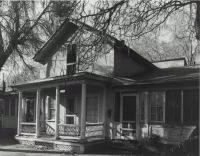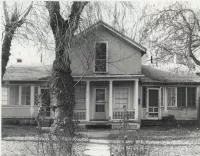Share what you know,
and discover more.
Share what you know,
and discover more.
Jul 20, 1983

-

- Charmaine Bantugan
National Register of Historic Places - John B. Kelly House
Statement of Significant: Built in the mid-1860s for John B. Kelly, who is reported to have established the first printing and book binding company in Utah, this house is significant as one of only two documented examples of a variant of the temple-form house in Utah which have survived to the present. The temple-form house originated from the Greek Revival period of American building, and typically has its short end to the street and a pedimented gable façade in imitation of monumental classical buildings. In its most common form, the house had symmetrical fenestration with a door placed to the side of center, and an opening leading to a side passage containing the staircase. Popularized by such books as Asher Benjamin's Builder's Companion and Minard Lafever's Modern Builder's Guide, it became one of the traditional house forms in New England and in the upper Midwest. The temple-form house migrated to Utah with the members of The Church of Jesus Christ of the Latter-Day Saints. The temple-form house type is important because i t is one of several early house types in the state, and because it is a type traceable to a New England cultural hearth, i t documents the important New England heritage of the early Mormon movement.' I t is one of seven basic house types that were found in Utah during the early years of settlement. These types are al l traditional and include: the square cabin; the rectangular cabin; the hall and parlor house; the central passageway house; the pair-house; and the double pen house. The temple-form house was popular in early Salt Lake City, a fact that is supported by early Sanborn-Paris Insurance maps, early photographs of the city, and a surprisingly accurate "bird's eye view" rendering of the city in 1870.9 Early residential development took place on the blocks which now comprise the city' s central business district. The temple-form house was found primarily in an area which changed dramatically during the late nineteenth century, consequently very few of these houses survive today. The pure temple-form was often modified in a number of ways. The most common type is referred to as a "modified" temple form in which the door is set in the side wing.' ' Another variant of the house type is evident in the Kelly House. The door is centered on the gable façade, it does not have a central or side passage, and may or may not have side wings (see plan). The Kelly House is one of only two houses identified in the state to have a door centered on the gable façade and two side wings. The other example is the Alma Staker House in Mount Pleasant, listed in the National Register.
National Register of Historic Places - John B. Kelly House
Statement of Significant: Built in the mid-1860s for John B. Kelly, who is reported to have established the first printing and book binding company in Utah, this house is significant as one of only two documented examples of a variant of the temple-form house in Utah which have survived to the present. The temple-form house originated from the Greek Revival period of American building, and typically has its short end to the street and a pedimented gable façade in imitation of monumental classical buildings. In its most common form, the house had symmetrical fenestration with a door placed to the side of center, and an opening leading to a side passage containing the staircase. Popularized by such books as Asher Benjamin's Builder's Companion and Minard Lafever's Modern Builder's Guide, it became one of the traditional house forms in New England and in the upper Midwest. The temple-form house migrated to Utah with the members of The Church of Jesus Christ of the Latter-Day Saints. The temple-form house type is important because i t is one of several early house types in the state, and because it is a type traceable to a New England cultural hearth, i t documents the important New England heritage of the early Mormon movement.' I t is one of seven basic house types that were found in Utah during the early years of settlement. These types are al l traditional and include: the square cabin; the rectangular cabin; the hall and parlor house; the central passageway house; the pair-house; and the double pen house. The temple-form house was popular in early Salt Lake City, a fact that is supported by early Sanborn-Paris Insurance maps, early photographs of the city, and a surprisingly accurate "bird's eye view" rendering of the city in 1870.9 Early residential development took place on the blocks which now comprise the city' s central business district. The temple-form house was found primarily in an area which changed dramatically during the late nineteenth century, consequently very few of these houses survive today. The pure temple-form was often modified in a number of ways. The most common type is referred to as a "modified" temple form in which the door is set in the side wing.' ' Another variant of the house type is evident in the Kelly House. The door is centered on the gable façade, it does not have a central or side passage, and may or may not have side wings (see plan). The Kelly House is one of only two houses identified in the state to have a door centered on the gable façade and two side wings. The other example is the Alma Staker House in Mount Pleasant, listed in the National Register.
Jul 20, 1983
National Register of Historic Places - John B. Kelly House
Statement of Significant:Built in the mid-1860s for John B. Kelly, who is reported to have established the first printing and book binding company in Utah, this house is significant as one of only two documented examples of a variant of the temple-form house in Utah which have survived to the present. The temple-form house originated from the Greek Revival period of American building, and typically has its short end to the street and a pedimented gable façade in imitation of monumental classical buildings. In its most common form, the house had symmetrical fenestration with a door placed to the side of center, and an opening leading to a side passage containing the staircase. Popularized by such books as Asher Benjamin's Builder's Companion and Minard Lafever's Modern Builder's Guide, it became one of the traditional house forms in New England and in the upper Midwest. The temple-form house migrated to Utah with the members of The Church of Jesus Christ of the Latter-Day Saints. The temple-form house type is important because i t is one of several early house types in the state, and because it is a type traceable to a New England cultural hearth, i t documents the important New England heritage of the early Mormon movement.' I t is one of seven basic house types that were found in Utah during the early years of settlement. These types are al l traditional and include: the square cabin; the rectangular cabin; the hall and parlor house; the central passageway house; the pair-house; and the double pen house. The temple-form house was popular in early Salt Lake City, a fact that is supported by early Sanborn-Paris Insurance maps, early photographs of the city, and a surprisingly accurate "bird's eye view" rendering of the city in 1870.9 Early residential development took place on the blocks which now comprise the city' s central business district. The temple-form house was found primarily in an area which changed dramatically during the late nineteenth century, consequently very few of these houses survive today. The pure temple-form was often modified in a number of ways. The most common type is referred to as a "modified" temple form in which the door is set in the side wing.' ' Another variant of the house type is evident in the Kelly House. The door is centered on the gable façade, it does not have a central or side passage, and may or may not have side wings (see plan). The Kelly House is one of only two houses identified in the state to have a door centered on the gable façade and two side wings. The other example is the Alma Staker House in Mount Pleasant, listed in the National Register.
Posted Date
Jun 28, 2023
Historical Record Date
Jul 20, 1983
Source Name
National Register of Historic Places
Source Website
Delete Story
Are you sure you want to delete this story?











